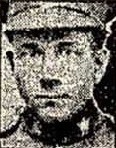Pte
George Sutton
Informationen zu Geburt
|
Geburtsdatum: 05/08/1890 |
|
Geburtsort: Newport, Monmouthshire, Wales, Vereinigtes Königreich |
Allgemeine Informationen
|
Beruf: Landwirt / Bauman / Ökonom |
Informationen zum Armeedienst
|
Land: Canada |
|
Truppe: Canadian Expeditionary Force |
|
Rang: Private |
|
Dienstnummer: 159639 |
|
Einberufung datum: 20/11/1915 |
|
Einberufung ort: Toronto, Ontario, Canada |
|
Einheiten: — Canadian Mounted Rifles, 4th Bn. (Letzte bekannte Einheit) |
Informationen zu Tod
|
Sterbedatum: 12/11/1917 |
|
Sterbeort: Abraham Heights, Zonnebeke, Belgien |
|
Todesursache: Im Kampf gefallen |
|
Alter: 27 |
Begräbnisplatz
|
White House Cemetery Grabstelle: II Reihe: E Grab: 12 |
Punkte von Interesse 3
| #1 | Geburtsort | ||
| #2 | Einberufung ort | ||
| #3 | Ort des Todes (ungefähr) |
Meine Geschichte
George Sutton was born in 1890 in Newport, Monmouthshire, Wales, where his parents, Sarah and Thomas, were lodging a house. George’s brother, William Dennis, was born in 1901. His father died that same year. In 1907 Sarah and William Dennis emigrated to Canada. A year later George’s mother is remarried with William Tarzwell from Everton, Ontario. When George enlisted in November 1915, his mother was living in Erin, Ontario, while George worked as a farmer near Toronto. He was initially assigned to the 81st Battalion. He sailed to Europe on the 28th of April 1916. In June 1916 he was transferred to the 4th Battalion of the Canadian Mounted Rifles (8th Brigade, 3rd Canadian Division).
On the 26th of October 1917 the 4th Mounted Rifles participated in the Second Battle of Passchendaele, attacking the Goudberg Heights, north of Passchendaele. The battalion managed to secure its objectives, but had to fall back to link up with the troops on their flanks. After the fighting the battalion was reorganised and was send back to the hinterland. The battalion was put under command of the 1st Canadian Royal Engineers and was divided in several road construction parties. Maintaining and repairing the roads was no easy task, due to the bad condition of the ground. Moreover, the exhausted groups were under a constant threat of German shelling and bombing. The units reported at Spree Dump and worked towards Kansas Cross and Abraham Heights.
On the 12th of November 1917 George Sutton, 27, was killed in action during these construction works. Four other soldiers were wounded. His remains were taken back to Ypres, where George was buried in White House Cemetery.
On the 26th of October 1917 the 4th Mounted Rifles participated in the Second Battle of Passchendaele, attacking the Goudberg Heights, north of Passchendaele. The battalion managed to secure its objectives, but had to fall back to link up with the troops on their flanks. After the fighting the battalion was reorganised and was send back to the hinterland. The battalion was put under command of the 1st Canadian Royal Engineers and was divided in several road construction parties. Maintaining and repairing the roads was no easy task, due to the bad condition of the ground. Moreover, the exhausted groups were under a constant threat of German shelling and bombing. The units reported at Spree Dump and worked towards Kansas Cross and Abraham Heights.
On the 12th of November 1917 George Sutton, 27, was killed in action during these construction works. Four other soldiers were wounded. His remains were taken back to Ypres, where George was buried in White House Cemetery.
